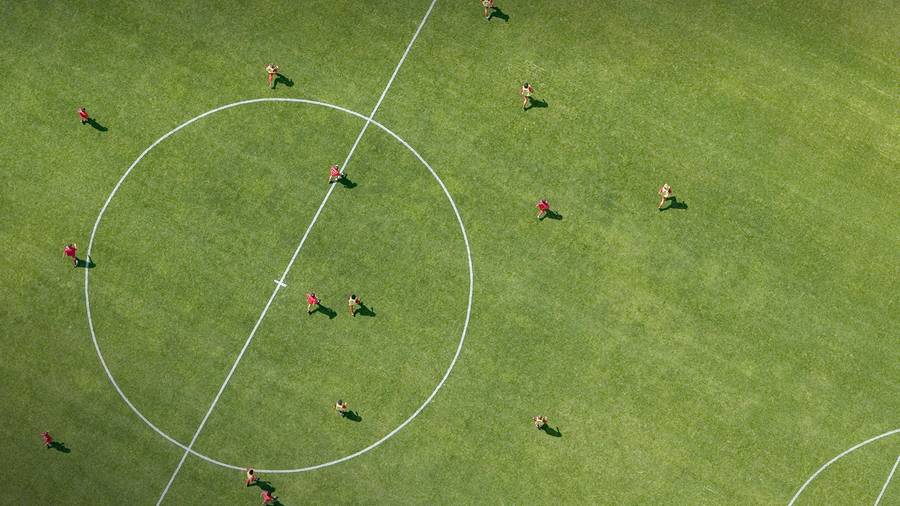Zonal marking is a widely implemented defensive strategy in football where players are tasked with guarding specific areas, or zones, of the pitch rather than marking individual opposing players. This approach contrasts with man-marking, where defenders are assigned specific opponents to track throughout the match.
Zonal marking is designed to organise a team’s defensive structure by ensuring that all critical spaces on the pitch are covered, thereby limiting the attacking options available to their opponents.
The success of zonal marking hinges on the discipline and spatial awareness of the team. Each player must understand their responsibilities within their designated zone and be ready to react to the opposition’s movements.
Effective communication and teamwork are vital, as defenders need to coordinate their efforts to prevent leaving gaps that can be exploited. It is a system that requires not just individual understanding, but also a collective tactical awareness.
While this method can offer a systematic and structured defence, it has its complexities. Teams that use zonal marking must be well-drilled to anticipate and respond to the dynamic nature of the game.
They must be able to quickly transition between attack and defence while maintaining their strategic integrity. Moreover, players must possess the capability to engage with attackers entering their zone and to be proactive in dealing with potential threats such as passes or crosses into their area.
Fundamentals of Zonal Marking
Zonal marking represents a strategic approach in football that prioritises area defence over individual marking. This section explores its definition, historical background, and comparison with man marking.
Defining Zonal Marking
Zonal marking is a defensive strategy in football where players are responsible for certain zones or areas of the pitch, rather than tracking specific opponents. The philosophy behind zonal marking is position-oriented, emphasising space control.
Players, when applying zonal marking, must be aware of threats within their area, maintaining defensive solidity by staying compact and shifting as a unit.
History and Evolution
The concept of zonal marking has evolved over time, with notable influence from Italian coach Arrigo Sacchi during the late 20th century. Sacchi championed a zonal defence with his AC Milan team, demonstrating its effectiveness at the highest level.
His philosophy promoted a collective team effort, with a high level of understanding between players, to maintain the integrity of the team’s shape.
Zonal vs. Man Marking
Zonal marking differs significantly from man marking, which is the traditional method where each defender is assigned a specific opponent to follow.
In contrast to man marking, zonal marking offers greater defensive flexibility and can reduce the risk of defensive gaps created by player’s movements.
| Aspect | Zonal Marking | Man Marking |
|---|---|---|
| Focus | Space/Area | Opponent |
| Player Movement | Within zone | Follows man |
| Flexibility | High | Lower |
| Coverage | Even | Varies |
Zonal marking assigns each player an area where they must react to threats dynamically, ensuring all regions of the pitch are covered. Man marking, however, relies on individual battles and can lead to mismatches or open spaces if a player is outmanoeuvred.
Implementing Zonal Marking
When implementing zonal marking, precision in player roles, defensive structure, communication, and movement is essential. Each player needs to understand their specific responsibilities and how to coordinate as a unit.
Player Roles and Responsibilities
Players adopt zones on the pitch rather than marking specific opposition players. Defenders are tasked with covering designated areas and only engage directly with attackers when they enter these zones.
Typically, the defensive line is comprised of centre-backs anchoring the central zones, while full-backs cover the wider areas. Midfielders may drop back to add a layer in front of defenders, enhancing the robustness of the shape.
- Defenders: Centre-backs cover central zones; full-backs handle wider areas.
- Midfielders: Provide additional coverage in front of the defensive line.
Defensive Shape and Structure
The defensive shape should adapt fluidly to the ball’s location. A common structure is a flat line across the penalty area to cover horizontal zones, which compresses or expands based on the ball's movement.
Example Defensive Line:
- 2 players on the posts
- 3 players along the six-yard line
- 3 players in front, staggered for depth
Communication and Coordination
Effective communication ensures players maintain the integrity of the defensive structure.
Each player needs to be vocal, signalling movements of the ball and opposition players, ensuring that the team's shape is not compromised.
Coordination allows for smooth transitions between zones and maintaining a compact defensive unit.
Key Components:
- Vocal Presence: Alert teammates to threats and changes.
- Collective Awareness: Keep track of all movement on the pitch.
Positioning and Movement
Players must position themselves in a manner that allows them to react quickly to the opposition's movements.
Awareness is critical, with each player required to observe both the ball and nearby threats.
Movement is generally lateral or backward, always aimed at maintaining balance in the defensive structure and closing off key passing lanes.
Movement Guidelines:
- Lateral: Preserve width within the zone.
- Backward: Keep depth to react to penetrating passes.
Zonal Marking in Action
Zonal marking is a tactical approach focusing on controlling key areas of the pitch through designated zones, particularly during set-pieces and open play. It requires a well-drilled defensive team and keen awareness of roles.
Set-Pieces
During set-pieces, such as corners or free-kicks, the defending team is often organised into a system where players are assigned specific zones to defend.
Typically, responsibilities may be distributed as follows:
- Near Post: One player is positioned near the near post to defend against low-driven deliveries.
- Six-Yard Box: A line of three players may strategically align along the six-yard box, clearing aerial balls and reducing shooting angles.
- Key Areas: Players outside the six-yard box prioritise defending spaces where the attacking team may look to exploit, like just inside the penalty spot or around the edge of the box.
In this system, the defending team does not focus on specific opposition players but instead aims to cover areas where the ball is likely to be played.
Open Play
In open play, zonal marking sees defenders holding a shape relative to the ball and their teammates, rather than tracking individual opposition players.
Key aspects include:
- Defensive Line: The defenders maintain a compact and shifting line according to ball movement, ensuring that gaps are minimised.
- Controlling Space: Players are responsible for intercepting passes and closing down attacks in their allocated zones, particularly in areas central to goal-scoring opportunities.
Communication and spatial awareness are pivotal, as defenders must work cohesively to cover the pitch effectively and react as a unit to the flow of play.
Tactical Considerations
In the context of zonal marking, the effective deployment hinges on strategic configuration of spaces and player movement. Teams must exhibit an astute understanding of spatial control and adaptability to counter the dynamic threats posed by the opposition.
Compactness and Spaces
The principle of compactness involves maintaining a reduced space between players to prevent opponents from exploiting gaps.
Coaches instruct players to stay connected, forming a closed block in either a high press or a low block depending on the scenario.
By keeping the distances between players minimal—especially in central zones—teams aim to deny pockets of space for the opposing players.
- High Press: Players engage opponents higher up the pitch to disrupt their build-up play.
- Low Block: Players retreat to a more condensed formation closer to their own goal, limiting the space for attacking players.
A team's ability to move as a unit is essential for preserving this compactness, making it more difficult for attackers to navigate through a robust defensive structure.
Pressing and Control
Pressing is a proactive measure in zonal marking where players apply pressure on the ball and surrounding areas to regain possession.
High pressing involves advancing up the pitch and confronting the opposition early, while strategic pressing in the midfield or defensive third is more about controlling specific zones and leading the opponent into less threatening areas.
- Pressing Triggers: Specific cues that signal for a team to apply a high press, such as a back pass.
- Zone Saturation: Densely populating key areas with defenders to assert dominance and control.
Adapting to Opponents' Play
Adaptability is crucial in zonal marking as each opponent presents a unique attacking approach.
Teams must adjust their defensive schemes in real-time, recognising movements, formations, and changing threats.
The defensive tactic must be malleable—flexing in response to the flow of the game and the specific tactics employed by the opposition.
- Switching Strategy: Alternating between different blocks and pressing intensities.
- Counter-Strategies: Preparing bespoke responses for anticipated opponent manoeuvres.
Anticipating an opponent’s offensive patterns and adapting the defensive setup accordingly can foil the attacking plans and ensure defensive solidity throughout the match.
It's about finding the balance between a predetermined structure and the fluidity required to negate the opposing player's influence.
Influence of Managers and Teams
Zonal marking’s effectiveness often hinges on how well managers understand the system and implement it with their teams.
Famous Managers and Their Systems
José Mourinho consistently utilises zonal marking principles, focussing on maintaining shape and discipline across his team's defensive block.
He has implemented this strategy during his time at various European clubs, leveraging the system to bolster defensive solidity.
Diego Simeone, the architect of Atlético Madrid's resurgence, espouses a more aggressive form of zonal marking, where his players exhibit high levels of pressure and tactical intelligence.
Atlético Madrid under Simeone is a prime example of zonal marking functioning with militaristic precision and collective cohesion.
Arrigo Sacchi revolutionised football with his defensive concepts at Milan.
Sacchi’s approach to zonal marking was rooted in collective team movement, a 4-4-2 formation with an emphasis on a high defensive line and synchronised pressing.
Iconic Teams and Their Implementation
Barcelona became synonymous with positional play and pressing, elements that complement zonal marking.
Under various managers, they utilised the system not just defensively but also to maintain the structure in the possession phase, making it difficult for opponents to regain the ball.
| Team | Manager | Implementation |
|---|---|---|
| Atlético Madrid | Diego Simeone | Aggressive pressure, collective defensive work. |
| Barcelona | Various | Maintains structure in both defensive and possession phases. |
| Milan | Arrigo Sacchi | High defensive line with synchronised team movements. |
In the context of zonal marking, these teams and managers illustrate the adaptability of the strategy, showcasing its utility in various systems, ultimately affecting the modern game's approach to defending and space control.
Individual and Collective Challenges
In zonal marking systems, the effectiveness of defending hinges on both individual discipline and collective understanding.
Mistakes and Misunderstandings
A defender's error in a zonal marking scheme can stem from misjudging the trajectory of the ball or misunderstanding their spatial responsibilities.
Unlike man marking, where defenders follow specific opponents, zone defenders must rely on reference points within their assigned area.
A lapse in concentration or a misread of the game can leave critical spaces unguarded and create opportunities for opponents to exploit.
Team Coordination and Cohesion
The success of zonal marking is underpinned by impeccable team coordination and cohesion.
Players must function as a unit with a clear analysis of unfolding play, adjusting their positions in harmony.
When a team lacks cohesion, markers can become isolated, rendering the defensive strategy ineffective.
Maintaining defensive stability requires all players to understand the dynamic nature of space and their role within the system.
Advancements in Defensive Tactics
Defensive play in football has undergone significant change with modern tactics such as zonal marking becoming standard components of defensive organization.
Modern Developments
The contemporary landscape of football has seen a shift towards a more sophisticated style of defensive tactics, emphasising both team discipline and the use of strategic zones.
Zonal marking is at the forefront of these developments. It assigns players to defend specific areas of the pitch rather than tracking individual opponents.
This method enhances a team's ability to maintain a strong, adaptable structure, enabling them to better manage space and counter opposing teams' formations.
Key Benefits:
- Increased Defensive Coverage: Players cover designated zones, creating a unified defensive network that is difficult for opponents to penetrate.
- Flexibility and Adaptability: Teams can react to the flow of the game without being bound to individual marking assignments.
Analytical Approaches
The rise of video analysis and data-driven strategies has allowed teams to refine their zonal marking systems with greater precision.
Coaches and analysts study match footage to understand patterns in opposition attacks, making informed adjustments to their defensive plans.
This preparation often involves examining set-pieces where zonal marking is critical, tailoring player positioning to negate the threat from these scenarios.
Use of Technology:
- Video Analysis: In-depth review of previous matches to improve tactical awareness and identify areas for improvement in defensive schemes.
- Data-Driven Planning: Use of statistics and performance analysis to develop effective defensive organization and to inform training sessions.
Comparison with Other Defensive Strategies
Zonal marking is distinct from other defensive strategies by its focus on space rather than individual players.
It's a structured approach where defenders are responsible for certain zones on the pitch, offering a cohesive defence against opponents.
Man-Oriented Cover Shadowing
In man-oriented cover shadowing, defenders are assigned an opposing player to mark, as well as a specific zone.
If an attacker enters their zone, they become the defender's responsibility.
This defensive strategy attempts to blend man-marking's direct opposition with zonal marking's spatial advantage.
Key references are the position of the attacker and the shadow the defender casts within their zone – always aiming to block passing lanes.
- Flexibility: Moderate, as players must adapt to both the opponent's position and their designated area.
- Defensive Strategy: Hybrid, with a focus on man-oriented marking within a zonal context.
Positional Play and Fluid Systems
Position-oriented systems elevate zonal marking by adding layers of flexibility and fluidity to the defensive strategy.
Here, players move collectively, depending on the ball's position, opposition movement, and teammates' locations.
This allows for a dynamic shape that adapts to the flow of the game.
| Defensive System | Flexibility Level | Strategy Focus |
|---|---|---|
| Man-Oriented Cover Shadowing | Moderate | Man with zone reference |
| Positional Play and Fluid Systems | High | Position-oriented |
Key Figures and Historical Context
In the history of football, the adoption of zonal marking can be traced back to key figures who have implemented and perfected this tactical approach, shaping the evolution of defensive philosophies.
Pioneers of Zonal Marking
One of the central figures in the development of zonal marking is Arrigo Sacchi, whose name is synonymous with revolutionary football tactics.
An Italian manager, Sacchi's philosophy was rooted in a position-oriented approach that discarded the traditional man-marking system.
In the 1980s and 1990s, his Milan side implemented a high defensive line, prioritising space over individual marking.
This approach required a synchronised unit that moved as one, and it transformed Milan into one of Europe's most formidable teams.
-
Key Principles:
- Emphasis on team shape over marking specific opponents
- High defensive line to compress play
-
Arrigo Sacchi's Contributions:
- Disruptive strategy in the context of Italian football's history
- Laid the foundation for modern defensive systems
Evolution of Defensive Philosophies
The influence of Sacchi and his principles set into motion a ripple effect that saw the evolution of zonal marking over the years.
Coaches have integrated the concept into a variety of systems, tailoring it to accommodate different formations and tactical setups.
As the principles of zonal marking have matured, they've become deeply embedded in the history and evolution of football tactics across Europe.
-
Adoption and Adaptation:
- Widespread incorporation across different leagues and football cultures
- Adaptation to various formations, from 4-4-2 to 3-5-2 and beyond
-
Tactical Nuances:
- Shifts from strict zones to fluid, dynamic space-coverage
- Increased use in set-piece situations
From Sacchi's Milan to modern-day football, zonal marking continues to be a testament to football's tactical innovation and adaptability.
Training and Drills
To optimise the efficacy of zonal marking, a coach should focus on drills that enhance players' spatial awareness and foster clear communication among teammates.
Practical Drills for Zonal Marking
One can begin with Zone Awareness Drills, setting up a grid using cones to demarcate specific zones.
Players are divided into attackers and defenders, with the objective for defenders to prevent attackers from entering their zones.
Movement within these zones is a key focus, and defenders must learn to shuffle collectively, responding to the ball's movement while maintaining their structural integrity.
These drills can include:
- Static Coned Defence: A drill using two teams with the aim of the defending team to stay in their assigned zones within a coned area and to clear the ball from their zone as quickly as possible.
- Dynamic Zone Control: This involves changing the size and shape of the zones dynamically throughout the drill to force defenders to adapt their positioning and communication strategies.
Improving Team Understanding
Beyond physical drills, improving team understanding is crucial for an effective zonal defence.
It involves breaking down scenarios in video analysis sessions, where players can visualise and discuss different situations.
Coaches should emphasise:
- The importance of Communication: Defenders should continuously communicate to cover unmarked zones and adapt to the movement of the ball and the opposition.
- Developing a robust Mental Map of their zones: Even without looking, each player should be aware of the boundaries of their zone and the precise location of teammates and opponents.
BeginInitiatively, teams perform drills that simulate match conditions without full defensive pressure, allowing players to practice their positioning and the fluidity of their zonal system.
As the team’s understanding improves, drills should gradually introduce real game pressure and unpredictability to test and solidify the defence strategy.
Future of Zonal Marking
The evolution of zonal marking continues to intrigue, particularly with rising tactical awareness influencing football strategies.
Predictions and Trends
One anticipates that zonal marking will witness enhanced precision in its application, driven by data analytics.
Teams will likely invest in technology to refine spacing and player positioning, leveraging real-time performance metrics.
An emerging trend is the blending of zonal principles with flexible man-orientations, creating hybrid systems that optimise defensive solidity without sacrificing the adaptability to dynamic in-game scenarios.
Innovations in Tactics
Tactical innovations often arise from the refinement of existing concepts rather than wholescale changes.
In the case of zonal marking, the incorporation of machine learning tools to predict and react to opponents' strategies may soon be a mainstay.
Advanced tactical training software facilitates the simulation of countless scenarios, ensuring players are better prepared for the variety of challenges they will face on the pitch.
With a focus on tactical awareness, coaches will likely develop more nuanced zonal schemes that counteract the intricacies of modern attacking play.


















